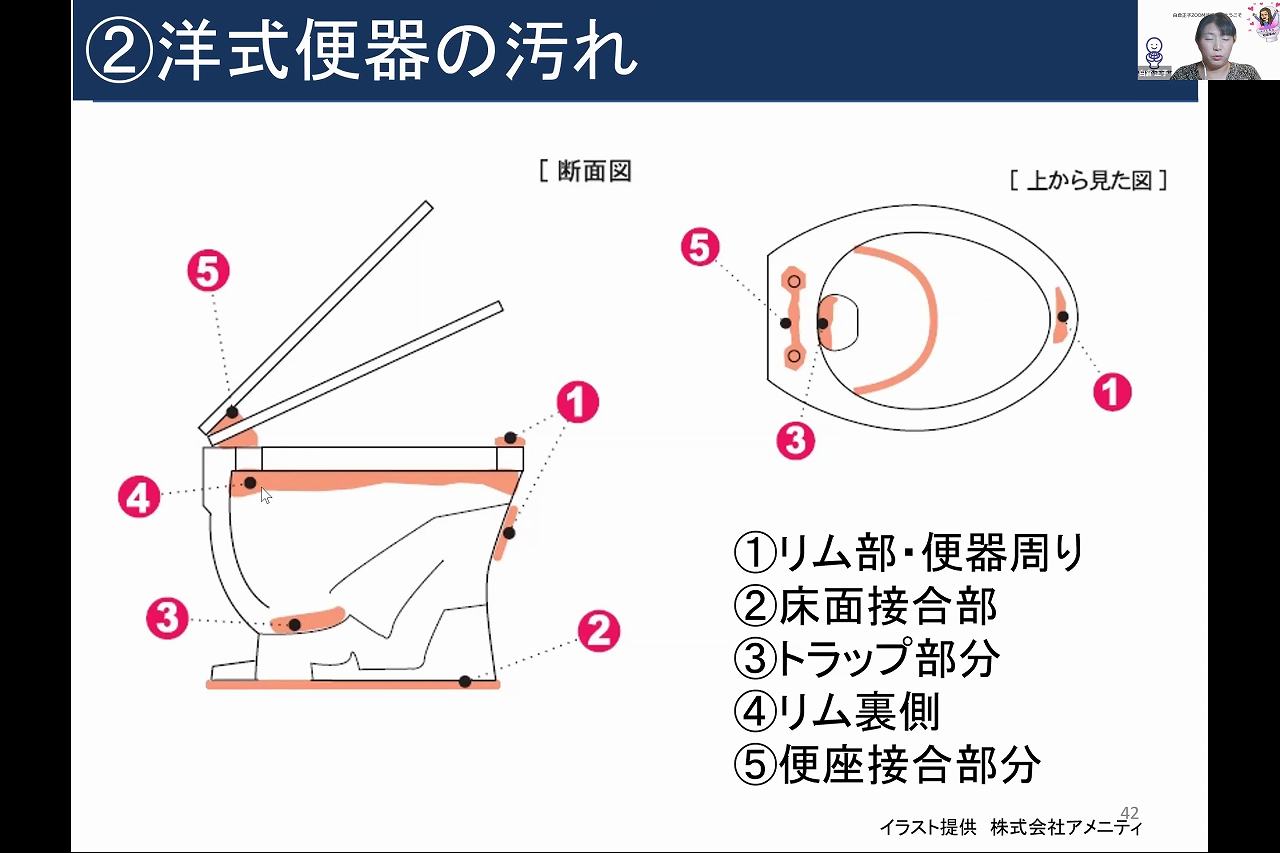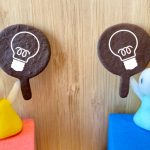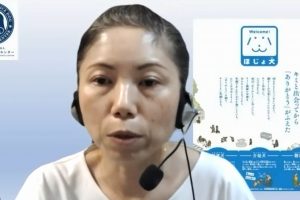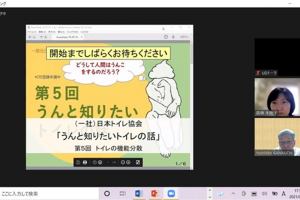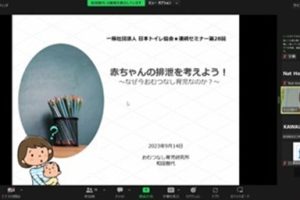The 13th seminar
“Toilet cleaning professionals introduce ways at home” and “Toilet diagnosticians”
Japan Toilet Association (JTA) Seminar Series
Date: 19 May 2022 (Thu) 18:00-20:00 JST
Presenters:
Masako Shirakura, Entoiletplanner proponent, JTA steering committee member
Nobutaka Yamato, Amenity Co., Ltd. CEO, JTA steering committee member
Organizer:
Yoshihiko Kawauchi, Ph.D., Japan Toilet Association vice chairperson,
Former professor of Toyo University.
Part 1: Toilet cleaning professionals introduce ways at home
Lecturer: Masako Shirakura
Chapter 1: My introduction with the toilet cleaning
It is 26 years have passed since I called myself a female toilet researcher. I have planned events and lectures related to the toilet. I am a JTA steering committee member and also a deputy secretary of the maintenance study group. I started to be a female toilet researcher after I finished my college bachelor graduation thesis on the toilet. At the time, the toilet cleaning was a pessimistic work, but I reflected it was wrong. I started myself the toilet cleaning training to get to know the reality of the toilet.
Chapter 2: Toilet cleaning tips for the typical toilet stains
Firstly, the typical stains on the toilet are urine splash. 2,300 drops are splashed by one person a day when a man stands and urinates according to a survey by Lion Co. Ltd. in 2015. More than 7,550 drops splash when urinate at the back of the stool.
Secondly, the urinary stones are a typical source of the dirt. The urine becomes colour brown and solid. It becomes harder than the concrete when it gets worse. In reality, it spreads bad order and causes clogging. The main component of the urinary stone is Calcium Carbonate (CaCO3) which is the same as an egg shell, and can be dissolved with an acidic detergent.
Thirdly, the dirt is composed of the mold and urinary stones. The toilet cleaning brush cannot reach there in the back. It is necessary to use the appropriate shape of the toilet brush.
Fourthly, typical dirt is the water stain and dust.
There are two types of the water stain; The first is the minerals such as calcium in the tab water. This can be removed with the citric acid or baking soda. The other is the calcium silicate in the tap water. This is persistent and can only be removed with the abrasive. However, that it would scratch the glaze on the surface of the toilet bowl, then the scratch becomes dirty and cannot be removed again. The important thing is to prevent the water stains from sticking. It is a nice idea to put the baking soda powder in the toilet tank to easily prevent this problem.
There are two ways to get rid of the water stains. The easiest way is to rub it with baking soda powder. The other way is to use a stick bar for removing water stains on the ceramics. The dirt caused by the excrement which can be easily removed by softening with water. It is better to sterilize it later.
● Toilet cleaner choice
The toilet-related detergents are sold at the home-centers and drug stores in Japan. Many customers wonder which one is the best to buy and use.
They are broadly classified into the following five categories;
(1) The cleanser for the toilet bowl and its surroundings.
(2) The deodorant and sterilizing by putting on.
(3) The bad odor elimination for after the excretion.
(4) The overnight soaking to remove the stains.
(5) The coating to prevent the toilet bowl from dirty.
Each detergent has a range and limitations of the efficacy. The point is to properly combine the purpose and effect. It is important to read the instructions carefully in order to understand the usage and performance of the detergent.
Nowadays, easy-to-use disposable cleaning products are popular, but they are not effective to remove the persistent stain. The manufacturer of the toilet bowl states that do not wipe the plastic parts such as the toilet seat and toilet lid with the dry paper. The modern spray-type detergents can be sprayed to the toilet paper and then use. It is better to spray the detergent on the entire paper to eliminate dry areas when using.
●The toilet cleansers
The neutral type detergents are good for simple daily stains, but not for persistent ones.
The acid detergent is effective in removing stains of the urine. On the other hand, the alkaline detergent is effective for hand stains, mold, oil, sterilization, etc. Both acidity and alkalinity are effective to remove the staining urinary stones and mold. It is necessary to prepare three types detergents; acidic, neutral, and alkaline. However, be aware of the generated toxic gas when use a chlorine-based detergent and an acidic one at the same time. If it is necessary to use both, rinse well one detergent with water and then use the other one, or use them on the different days.
It is important not to try to remove it at once but wait for a few days when the dirt is too persistent. Three type detergents should be prepared; the citric acid, the baking soda and neutral one. The baking soda and the citric acid are basically possible to mix. However, better to use them separately although without foaming, as it is neutralized and the effect will be diminished when mixing them. It is better not to use the citric acid or the baking soda for the aluminum, iron, marble and cement.
It’s a good idea to clean them regularly with the neutral detergent to avoid such a problem. A new gel-like detergent works for the persistent stains. It is easier to remove persistent dirt soon since it will adhere to the dirt. You can get the same effect detergent cheaply when you dissolve the citric acid powder or baking soda powder in the warmer water and add a little starch to it.
●Toilet cleaning consciousness and procedure
There are often success stories in the business by means of the cleaning the toilet. Then thinking “Cleaning the toilet may be profitable!” could remove the awareness of weakness. It is essential to wear an apron, rubber gloves, and a mask when cleaning.
The cleaning process direction is from the top to the bottom, from the back to the front, and from light dirt to heavy one. For example, the orders are the ceiling, the ventilation fan, the wall, the dust in the back of the toilet bowl, around the toilet bowl, the floor, and the washbasin in the toilet. Finally, the sterilization is recommended.
A hand mirror helps to find hard-to-see stains. A microfiber cloth is highly recommended. The ordinary towels may damage the plastic since the toilet equipment is delicate. It is advisable to prepare four soft microfiber clothes with the different colours and use them separately such as for toilet bowls and wash basins. In addition, it is effective to bring a sponge to wipe the washbasin, a toilet brush, a used toothbrush, a cleaning brush for shoes, and various shape brushes to access the details.
Chapter 3 Maintenance method for the toilet equipment
The urine stains remain on the back of the half-dome shape nicknamed “Kinkakushi” in the Japanese crouching style toilet. Sometimes the brush cannot reach the deep part where water flows out. In that case, the only way is to clean by the hand wearing the rubber gloves. The side of the Japanese crouching style toilet is prone to urine stains causing bad odor. The tiled floor is also odorous as the urine soaks into the joints. However, the joints will melt after washing it with the acidic detergent. In that case, it is recommended to cover with the coating by the professionals. To sprinkle with an acid detergent and rinse with plenty of water are effective to remove the minor stains.
The next introduction is the cleaning method on the toilet bowl.
The hinge part of the toilet seat tends to keep the dirty by the male urine. The outside of the toilet bowl, the floor, the rim of the toilet bowl, the back of the toilet seat, and the back of the toilet bowl are easily soiled. Find it by using a mirror. Use a brush to reach the rim. As for the cleaning procedure inside the toilet bowl, it will be easier to clean with the accumulated water into the back with a brush or pump to drain the water. Sprinkle the detergent on it, whisk it, and leave it for a while to dissolve the dirt, then flush the water to finish. Spray directly on the toilet bowl with the citric acid and baking soda which are no foaming. Mind not to let the cleaner inhale the detergents directly.
To remove the persistent stains, spread toilet paper, sprinkle a lot of detergent on it, and wait a while before flushing it. Wipe the surface of toilet plastic seat with a neutral detergent or use a microfiber cloth. In case of the toilet paper, moisten it thoroughly with the water. The urine stones may stick on the plastic joints of the toilet seat, then use the urine stone gel and wait a while, and then remove the gaps with a toothpick or skewer. The rubber part on the back of the toilet seat named a cushion rubber may also get dirty with the urine. The cushion rubber of the specified manufacture can be replaced. When it turns yellow, soak it in a cup with the chlorine bleach or the acidic detergent.
There are some removable toilet spray seats which have the functions of warming the seat and washing the anus by the shower. Please check the pdf instruction manual on the website called Toilet Navi which introduces the site to download.
https://www.sanitary-net.com/clean/manual.html
At first, unplug the electricity of the toilet seat for cleaning for toilet bowl with warm water flush system. There is a plate underneath after removing the seat. Do mind if you spray it, the liquid will get into the main body, when wiping the urine stones there. Instead, soak the wiping cloth with the detergent.
Use a cotton swab to clean the small holes in the toilet spray seat. Prepare the two plastic bottle caps, put there of the acid detergent and water in each, and use a cotton swab to clean the detail parts. Rub the dust on the filter to deodorize the seat with a toothbrush. The nozzle of the toilet spray seat comes out with pressing the cleaning control buttons of the remote control. Clean it with the alkaline and detergents such as the citric acid. The life cycle of the toilet spray seat is about ten years. It is necessary to check the toilet seat rattle, cracks, the unbalanced of the heated area and water dripping.
Clean and sterilize the hand stains on the toilet paper holder and the control buttons caring about infectious diseases. The splashing urine remains on the floor of the toilet. Wiping with a neutral detergent is not enough, but the citric acid is effective with a deodorizing effect. To clean the gap between the floor and the toilet bowl, wrap a plastic card in a cloth, put it in the gap, and rub it.
The water splashes and soap stains on the washbasin can be cleaned with a neutral detergent, citric acid, and baking soda. The cleaning metal part can be used the alkaline or acidic. For the water splashes on the mirror above the wash basin, sprinkle water with the citric acid, put a wrap film on it, leave it for a while, and then roll the wrap film and rub the mirror to clean it. The dust often adheres to the ventilation fan in the toilet.
There is also a method of applying the coating to the surface of the toilet bowl or floor to prevent from getting dirty. There is a toilet seat to spray disinfectant water to clean the inside of toilet bowl. There are also products to make bubbles on the surface of the toilet bowl to prevent the urine to bounce.
There exist various skills in the JTA maintenance study group. For example, the skills to clean the water stain on the urinals, to coat the floor, and to clean the drains adhered the persistent urinary stones.
Chapter 4. Cleaning the toilet will change next society
80% or more of ethanol and benzalkonium chloride are effective, easy to obtain, inexpensive, and do not discolour the toilet seat when using it against COVID-19. Soak the disinfectant in the cloth or paper to dispose and wipe it in one direction. Wipe things which people daily touch in the toilet. They are the doorknobs, soap pump parts, toilet seats, toilet lids, remote control buttons, handrails, paper holders, etc. Please take appropriate measures as it has not been confirmed that the excrement is the main cause of COVID-19, but the norovirus spreads due to it.
Part 2: The toilet diagnosticians
Lecturer: Nobutaka Yamato
Amenity Co., Ltd., specializes in the toilet maintenance. The headquarter is in Yokohama, Japan and there are about 60 franchise companies in Japan from Hokkaido in the north to Okinawa in the south and two companies in South Korea. A toilet diagnosis is performed in the “THE TOKYO TOILET” project by the Nippon Foundation.
Our service consists of three business areas.
● Refresh maintenance service
A functional and aesthetic restoration service that restores the functions and aesthetics of the toilet equipment.
● The renewal support service
The equipment improvement support.
A service that improves the comfort of the toilet by the new equipment improvement.
● The repeating maintenance service
A maintenance service that is our main work to keep the comfort of the toilet every month. The toilet diagnostician supplies the drugs every month to prevent from sticking of urinal stones, and changes the deodorant to suppress the bad odor and the toilet seat disinfectant sheets, so that it keeps comfortable without odor and creates a nice toilet space. We will not only change the drugs but also perform maintenance by the human hands to create a comfortable toilet.
The toilet diagnosis is growing service business in addition to these three services above.
This looks just like a health check performed by the toilet diagnostician. The toilet diagnosis is based not on the qualitative but quantitative manner. For example, the toilet is ventilated 5.4 times an hour, 3ppm of ammonia is generated from the urinal, the odor concentration of the men’s toilet is 240, the illuminance of the toilet is 30 lux which is a little dark. The Escherichia coli was found in the crib, and it seems to be contaminated with the feces. There must be three reasons why the toilet diagnosis is supported by the customers.
The first reason is that it is easy to recognize. For example, even in a human health examination, it is better to tell that the body temperature was 40 degrees than to tell it was feverish.
The second reason is that everybody can see the real problem. There is a little inflammation in the lungs looking at with an X-ray rather than putting a stethoscope on the chest and told “You have a cold” at the hospital. It feels much more relieved to be told that the illness is due to bacteria. It is cured with taking the antibiotics and the fever will be normal soon.
The third reason is that the result is unique no matter who measures it, therefore it can become a standard. Anyone can measure the body temperature in the same way with using a thermometer. This toilet diagnosis was once applied in the places where were lots of toilets and then a certain standard was required to maintain them. The toilet diagnosticians are nominated as an in-house qualification by Amenity Co., Ltd. and the franchised companies. There are two grade levels; grade 1, grade 2, and this qualification system certified by the Ministry of Health, Labor and Welfare. It is given to those who have the ability to comprehensively diagnose on the equipment in the toilet room and identify the reasons of actual and latent troubles.
● The measurement of the ventilation capacity
The toilet room ventilation is measured how many times the air in the room changes in an hour by an anemometer. It is normally recommended to change the room air in the toilet 10 to 15 times an hour. However, it often does not change at all when actually measured.
● The measurement of the odor
There are two ways to quantify odors: measuring the substances and measuring by the human sensibility.
The method of measuring a substance is called the component concentration measurement, and it examines how many substances cause the bad odor. It is an effective diagnostic method when the odor component or the source of the bad odor are specified. It measures ammonia, hydrogen sulfide methyl mercaptan, carbon dioxide, etc. The human noses can actually identify 400,000 different odor types, and then the measuring substances cannot naturally cover all. There is a method called the sense of smell measurement method by means of the human sense of smell.
Stinks are rarely made up of a single substance, but often a mixture of multiple odor molecules. For example, cigarette smoke is composed of about 1,000 chemicals. In that case, the odor is measured by a specialist named the national certificated odor judge. The measurement method is stipulated in the Japanese Offensive Odor Control Law. By the way, I am not only a toilet diagnostician but also the odor judge.
● Use of an endoscope.
This is the same as a medical endoscope, and it is inserted into the drainage pipe of the urinal or toilet bowl. In addition to this, we use an illuminometer and recently carry out ATP (Adenosine tri-phosphate) wiping inspections for COVID-19. The numerical values in this inspection are defined as the dirt indicators. 1 to 2000 is pass, 2001 to 4000 is caution, and 4000 or more is fail. The user hands touching parts are usually filthy. One example is that the toilet door key was 7358. The wash buttons are also filthy. The lid of the paper holder was 8179. After those, we used to check E. coli and count the user numbers.
[A1: Kayamori on behalf of Shirakura] Sodium hypochlorite is effective in removing the mold. Sodium hydrogen carbonate is a baking soda and is effective for removing the sebum stains, so it is suitable for wiping persistent stains on the toilet seat, operational panel, toilet paper holder, and so on. [Q2: Na] Ms. Shirakura said it was made by mixing the citric acid and baking soda with the starch powder to make it be a gel. However, when mixed the citric acid and baking soda, it must be neutralized because the mixture of the acid and the alkali. Is it effective to use?
[A2: Kayamori] She does not mean to mix together, but that the citric acid and baking soda are mixed separately. At that time, there are no problem to mix, but it becomes foams quite a lot. When the mixture of the starch, the temperature raises to 60 ° C or higher, and their crystal structure collapses, the molecule becomes larger, and the viscosity increases. [Q3: Ok] Sometimes toilet bowls are clogging in the public toilets. What is the maximum limit of toilet paper usage to prevent clogging?
[A3: Kawauchi] It may be a quite vague answer, but it can only be said within our common sense. [Q4: Anonymous] The toilet seat disinfectant cleaner is used by spraying it on toilet paper, but I am afraid that it will scratch the toilet seat?
[A4: Yamato] The hard paper such as a writing paper pad may damage, but soft paper must not damage. It’s better to use the paper a little wet, but you don’t worry so much. [Q5: Ho] Is there any restrictions for the odor judges on their lives such as prohibiting from smoking or drinking?
[A5: Yamato] The odor judge can pass if the person can accurately distinguish among five standard odors. Basically, anyone with a normal sense of smell will be able to pass it. They can drink alcohol and there are no strict restrictions on the daily life. [Q6: Kawauchi] Can the chemicals remove urinary stones? Otherwise, is it something like a spatula at first and then finished with the chemicals?
[A6: Yamato] The urinary stone is composed of calcium carbonate and calcium oxalate, and it is a similar component as human bones. At first, soften the urinary stones in the pipe by the strong hydrochloric acid of 24%. After that, the urinary stones are peeled off using a machine called a flex metal spin shaft, and then washed off with a high-pressured water. [Q7: Kawauchi] The toilet pipe is PVC. Isn’t it damaged by the chemicals?
[A7: Yamato] PVC is not corroded by the acid. The lead pipes are corroded and it is necessary to take into consideration. While inserting the endoscope, put the hydrochloric acid drip device together with the flex shaft, the hose for high-pressure washing and proceed with the work of peeling off while checking the condition of the pipe. [Q8: To] I scratched the toilet bowl trying to remove the persistent stains. Can DIY amateurs make the coating by themselves?
[A8: Shirakura] Refer to “the toilet coating” on the internet, there are some of cheap products, but they must be soon peeling off. I think it’s safer to ask to the professionals. Many of the members of the maintenance study group in JTA are working for the public toilets rather than home ones, but we can introduce someone. [Q9: Ho] How do you record the toilet maintenance logs, just like a patient medical record in the hospital?
[A9: Yamato] The log record is essential since each toilet has the tendency or characteristics to become dirty or deteriorate. [Q10: Ho] In that case, what kind of items are essential to list up?
[A10: Yamato] “THE TOKYO TOILET” is observing from the viewpoint whether the particular toilet is used along the intended plan. We check every month for the broken soap containers, defects and dirt. [Q11: Kawauchi] Does the toilet diagnosis result point out that the number of cleanings is not enough?
[A11: Yamato] Naturally it will be done. It also depends on the toilet usage. Whenever there are problems, they will point them out. The problems are spontaneously different in each toilet. The hardly used toilets shall be cleaned more frequently. Whereas, it is not necessary to increase the cleaning activities so much at the low usage ones. The cleaning cycles deeply depend on the user usage manners.
